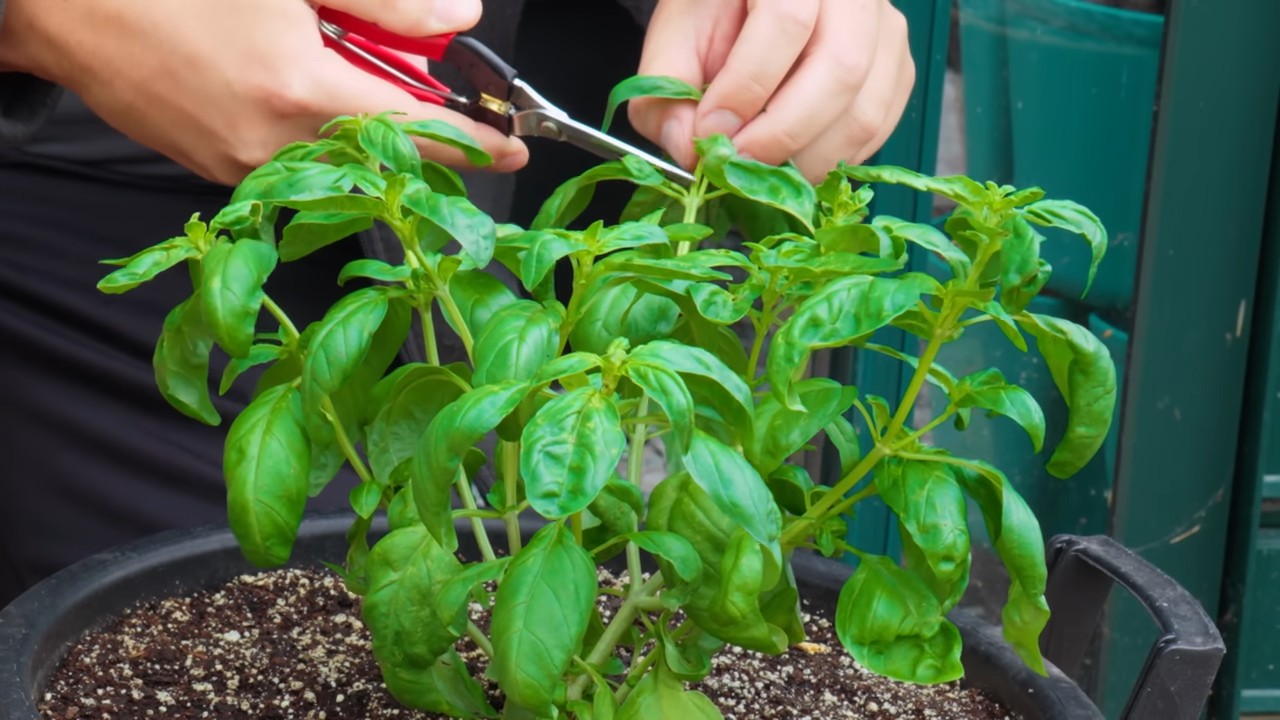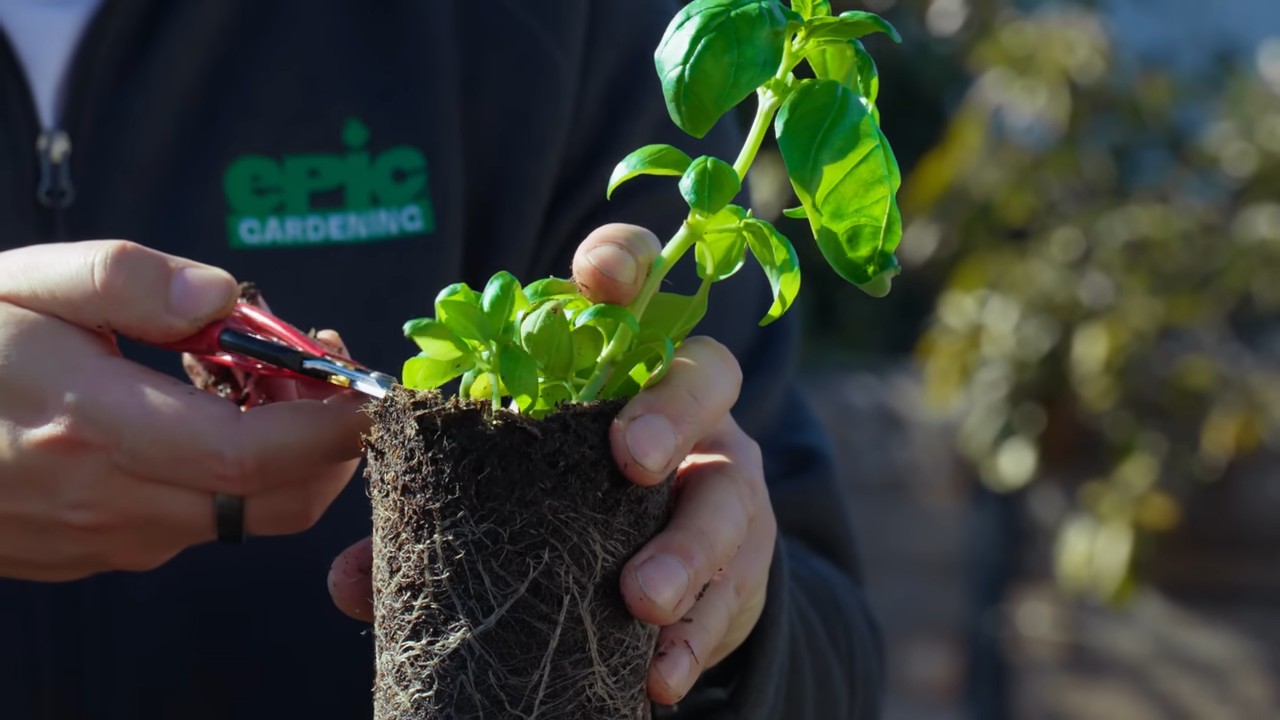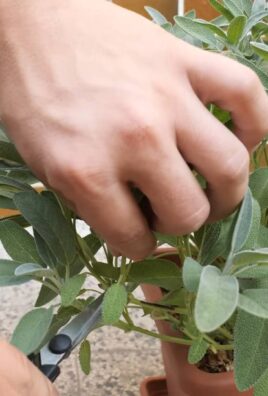Grow Basil at Home – and unlock a world of flavor right outside your door! Have you ever dreamt of snipping fresh, fragrant basil leaves just moments before adding them to your pasta sauce or pesto? It’s easier than you think, and this DIY guide is your ticket to becoming a basil-growing pro, even if you’ve never gardened before.
Basil, with its rich history stretching back to ancient times, wasn’t always just a culinary herb. In some cultures, it was revered for its medicinal properties and even considered a symbol of love and protection. From the royal gardens of ancient Greece to the sun-drenched fields of Italy, basil has captivated hearts and palates for centuries.
But why should *you* learn to grow basil at home? Well, store-bought basil can be expensive and often lacks the vibrant flavor of freshly grown herbs. Plus, knowing exactly where your food comes from is incredibly satisfying! This DIY article is packed with simple, effective tricks and hacks that will help you cultivate a thriving basil plant, regardless of your space or experience. Imagine the joy of adding that burst of fresh basil to your meals, knowing you grew it yourself. Let’s get started and transform your home into a fragrant, flavorful oasis!

Grow Your Own Delicious Basil: A DIY Guide
Hey there, fellow plant enthusiasts! I’m so excited to share my tried-and-true method for growing vibrant, fragrant basil right in your own home. Forget those wilted, overpriced bunches at the grocery store – with a little effort, you can have a constant supply of fresh basil for all your culinary adventures. Let’s get started!
What You’ll Need
Before we dive in, let’s gather our supplies. This is a pretty straightforward project, so you probably have a lot of these items already.
* Basil Seeds: Choose your favorite variety! Genovese is a classic, but lemon basil, Thai basil, and purple basil are also fantastic options.
* Seed Starting Tray or Small Pots: These will be your nurseries for the baby basil plants.
* Seed Starting Mix: This is a light, airy soil mix specifically designed for seedlings. Regular potting soil can be too heavy.
* Spray Bottle: For gently watering the seedlings.
* Grow Lights (Optional but Recommended): Especially if you don’t have a super sunny windowsill.
* Potting Soil: For transplanting the basil into larger containers.
* Larger Pots or Containers: At least 6 inches in diameter, with drainage holes.
* Watering Can or Hose: For watering the mature plants.
* Liquid Fertilizer: A balanced fertilizer to feed your basil plants.
* Scissors or Pruning Shears: For harvesting and pruning.
Starting Your Basil Seeds
This is where the magic begins! We’re going to nurture those tiny seeds into healthy seedlings.
1. Prepare Your Seed Starting Tray or Pots: Fill your seed starting tray or small pots with seed starting mix. Gently pat it down, but don’t compact it too much. You want the soil to be loose and well-draining.
2. Sow the Seeds: Sprinkle a few basil seeds on top of the soil in each cell or pot. Basil seeds are tiny, so don’t overdo it. I usually aim for 2-3 seeds per cell.
3. Cover the Seeds Lightly: Sprinkle a very thin layer of seed starting mix over the seeds. They need light to germinate, so don’t bury them too deep.
4. Water Gently: Use your spray bottle to mist the soil thoroughly. You want it to be moist but not soggy. Avoid pouring water directly onto the seeds, as this can dislodge them.
5. Provide Light and Warmth: Place your seed starting tray or pots in a warm location with plenty of light. A sunny windowsill is great, but grow lights are even better, especially if you live in a place with limited sunlight. I keep my grow lights on for about 14-16 hours a day.
6. Maintain Moisture: Keep the soil consistently moist by misting it regularly with your spray bottle. Don’t let it dry out, but also avoid overwatering, which can lead to damping off (a fungal disease that kills seedlings).
7. Be Patient: Basil seeds typically germinate in 5-10 days. Once you see those little green sprouts emerge, you’re on your way!
Transplanting Your Basil Seedlings
Once your seedlings have developed a few sets of true leaves (the leaves that look like miniature basil leaves, not just the initial seed leaves), it’s time to transplant them into larger containers.
1. Prepare Your Larger Pots: Fill your larger pots or containers with potting soil. Again, gently pat it down, but don’t compact it too much.
2. Carefully Remove the Seedlings: Gently loosen the soil around the seedlings in the seed starting tray or pots. You can use a small spoon or fork to help you. Be very careful not to damage the delicate roots.
3. Separate the Seedlings (If Necessary): If you planted multiple seeds in each cell or pot, gently separate the seedlings. Try to keep as much of the root system intact as possible.
4. Plant the Seedlings: Make a small hole in the potting soil in your larger pot. Place the seedling in the hole and gently cover the roots with soil. The top of the root ball should be level with the surface of the soil.
5. Water Thoroughly: Water the newly transplanted seedlings thoroughly. This will help settle the soil around the roots.
6. Provide Light and Warmth: Place the transplanted seedlings in a sunny location or under grow lights.
Caring for Your Basil Plants
Now that your basil plants are in their permanent homes, it’s time to provide them with the care they need to thrive.
1. Watering: Basil plants need consistent moisture, but they don’t like to be waterlogged. Water them when the top inch of soil feels dry to the touch. Avoid getting the leaves wet, as this can promote fungal diseases. Water deeply, allowing the water to drain out of the drainage holes.
2. Fertilizing: Basil plants are heavy feeders, so they need regular fertilization. Use a balanced liquid fertilizer every 2-3 weeks. Follow the instructions on the fertilizer package.
3. Light: Basil plants need at least 6 hours of sunlight per day. If you’re growing them indoors, provide them with supplemental light from grow lights.
4. Pruning: Pruning is essential for keeping your basil plants healthy and productive. When the plants are about 6 inches tall, pinch off the top set of leaves. This will encourage the plant to branch out and produce more leaves. Continue to pinch off the top sets of leaves regularly throughout the growing season.
5. Pest Control: Basil plants are generally pest-resistant, but they can occasionally be attacked by aphids, spider mites, or whiteflies. If you notice any pests, try spraying the plants with a strong stream of water or using an insecticidal soap.
6. Flowering: Basil plants will eventually flower. When they do, the leaves will become bitter. To prevent flowering, pinch off the flower buds as soon as you see them. However, you can also let some of your basil plants flower to attract pollinators to your garden.
Harvesting Your Basil
The best part! Harvesting your basil is easy and rewarding.
1. Harvest Regularly: The more you harvest, the more your basil plants will produce. Harvest the leaves in the morning, when they are at their peak flavor.
2. Pinch or Cut the Leaves: Pinch or cut the leaves off the plant just above a set of leaves. This will encourage the plant to branch out and produce more leaves.
3. Use Fresh or Preserve: Use the fresh basil leaves immediately or preserve them for later use. You can dry them, freeze them, or make pesto.
Troubleshooting
Even with the best care, you might encounter some problems along the way. Here are a few common issues and how to address them:
* Yellowing Leaves: This can be caused by overwatering, underwatering, nutrient deficiencies, or pests. Check the soil moisture, fertilize the plants, and inspect them for pests.
* Wilting Leaves: This is usually caused by underwatering. Water the plants thoroughly.
* Leggy Growth: This is usually caused by insufficient light. Provide the plants with more light.
* Damping Off: This is a fungal disease that kills seedlings. Avoid overwatering and provide good air circulation.
Choosing the Right Basil Variety
While Genovese basil is the most common, exploring different varieties can add exciting flavors to your dishes. Here are a few of my favorites:
* Genovese Basil: The classic Italian basil with a sweet, slightly peppery flavor. Perfect for pesto, pasta sauces, and salads.
* Lemon Basil: A refreshing basil with a distinct lemon flavor. Great for teas, salads, and seafood dishes.
* Thai Basil: A licorice-flavored basil with purple stems and flowers. Essential for Thai cuisine, especially curries and stir-fries.
* Purple Basil: A beautiful basil with dark purple leaves and a slightly spicy flavor. Adds a pop of color to salads and other dishes.
Tips for Success
Here are a few extra tips to help you grow the best basil possible:
* Use Well-Draining Soil: Basil plants don’t like to sit in soggy soil. Make sure your potting soil is well-draining.
* Provide Good Air Circulation: Good air circulation will help prevent fungal diseases.
* Rotate Your Crops: If you’re growing basil in the same location year after year, rotate your crops to prevent soilborne diseases.
* Don’t Overcrowd Your Plants: Give your basil plants enough space to grow. Overcrowding can lead to poor air circulation and increased disease risk.
* Enjoy Your Harvest! Don’t be afraid to experiment with different ways to use your fresh basil.
Growing your own basil is a rewarding experience that will provide you with a

Conclusion
So, there you have it! Growing basil at home isn’t just a fun project; it’s a gateway to fresher, more flavorful meals and a more sustainable lifestyle. We’ve walked you through the simple steps, from choosing the right variety to harvesting your fragrant leaves. The benefits are undeniable: you’ll have a constant supply of fresh basil, free from pesticides and preservatives, right at your fingertips. Plus, the satisfaction of nurturing a plant from seed (or cutting!) to harvest is incredibly rewarding.
Why is this DIY trick a must-try? Because it empowers you to take control of your food source, even in a small way. Imagine adding freshly picked basil to your pasta sauce, sprinkling it over a Caprese salad, or infusing it into homemade pesto. The difference in taste compared to store-bought basil is remarkable. You’ll be amazed at the vibrant aroma and intense flavor that homegrown basil brings to your dishes.
But don’t stop there! Experiment with different varieties of basil to discover your favorites. Try growing Thai basil for Asian-inspired dishes, lemon basil for a citrusy twist, or purple basil for a beautiful and flavorful garnish. You can also explore different growing methods, such as hydroponics or container gardening, to find what works best for your space and lifestyle. Consider companion planting your basil with tomatoes, peppers, or other vegetables to deter pests and improve their growth.
We encourage you to embark on this green adventure and experience the joy of growing basil at home. It’s easier than you think, and the rewards are well worth the effort. Don’t be afraid to get your hands dirty and learn along the way. Every gardener, no matter how experienced, started somewhere.
Once you’ve harvested your first batch of homegrown basil, we’d love to hear about your experience! Share your tips, tricks, and favorite recipes in the comments below. Let’s create a community of basil-loving gardeners and inspire others to grow their own fresh herbs. Show us your basil plants and the delicious meals you’ve created with them. Your insights could be invaluable to someone just starting out. Happy growing!
Frequently Asked Questions (FAQs)
Q: What are the best basil varieties to grow at home?
A: The “best” variety really depends on your personal preferences and culinary needs. Sweet basil is the most common and versatile, perfect for Italian dishes and pesto. Thai basil has a distinct anise flavor and is ideal for Southeast Asian cuisine. Lemon basil offers a refreshing citrusy aroma and taste, great for salads and teas. Purple basil adds a beautiful color and a slightly different flavor profile to your dishes. Consider growing a few different varieties to experiment and find your favorites. Genovese basil is also a popular choice for its classic basil flavor and large leaves.
Q: How much sunlight does basil need?
A: Basil thrives in full sun, meaning it needs at least 6-8 hours of direct sunlight per day. If you’re growing basil indoors, place it near a sunny window or use a grow light to supplement natural light. Insufficient sunlight can lead to leggy growth and reduced flavor. If you notice your basil stretching towards the light, it’s a sign that it needs more sun. Rotate your basil plant regularly to ensure even exposure to sunlight.
Q: What kind of soil is best for growing basil?
A: Basil prefers well-draining soil that is rich in organic matter. A good potting mix specifically formulated for herbs or vegetables is a great choice. You can also amend your garden soil with compost or other organic materials to improve its drainage and fertility. Avoid heavy clay soils, as they can retain too much moisture and lead to root rot. The ideal soil pH for basil is between 6.0 and 7.5.
Q: How often should I water my basil plant?
A: Water your basil plant regularly, keeping the soil consistently moist but not waterlogged. Check the soil moisture by sticking your finger about an inch deep into the soil. If it feels dry, it’s time to water. Avoid overwatering, as this can lead to root rot. Water deeply, allowing the water to drain out of the bottom of the pot. During hot weather, you may need to water more frequently. Mulching around the base of the plant can help retain moisture and reduce the need for frequent watering.
Q: How do I harvest basil without killing the plant?
A: The key to harvesting basil without harming the plant is to prune it regularly. Pinch off the top sets of leaves, just above a leaf node (where leaves grow out from the stem). This encourages the plant to branch out and produce more leaves. Avoid cutting off more than one-third of the plant at a time. When harvesting, prioritize the larger, older leaves, as they tend to have the most flavor. Regular harvesting will also prevent the plant from flowering, which can reduce the flavor of the leaves.
Q: How do I prevent my basil from flowering?
A: Once basil starts to flower, it signals the end of its vegetative growth, and the leaves can become bitter. To prevent flowering, regularly pinch off the flower buds as soon as you see them. This will encourage the plant to focus its energy on producing more leaves. If your basil plant does flower, you can still use the flowers in salads or as a garnish, but the leaves may not be as flavorful.
Q: What are some common pests and diseases that affect basil?
A: Basil can be susceptible to pests such as aphids, spider mites, and whiteflies. Regularly inspect your plants for signs of infestation and take action promptly. You can often control these pests by spraying the plants with a strong stream of water or using insecticidal soap. Basil can also be affected by fungal diseases such as powdery mildew and downy mildew. To prevent these diseases, ensure good air circulation around the plants and avoid overhead watering. If you notice signs of disease, remove the affected leaves and treat the plant with a fungicide.
Q: Can I grow basil indoors year-round?
A: Yes, you can grow basil indoors year-round, provided you provide it with adequate light, water, and nutrients. Place your basil plant near a sunny window or use a grow light to supplement natural light. Water regularly, keeping the soil consistently moist but not waterlogged. Fertilize the plant every few weeks with a balanced liquid fertilizer. With proper care, you can enjoy fresh basil even during the winter months.
Q: How can I propagate basil from cuttings?
A: Propagating basil from cuttings is a simple and effective way to create new plants. Take a cutting that is about 4-6 inches long, removing the lower leaves. Place the cutting in a glass of water, ensuring that the leaves are above the waterline. Place the glass in a bright, indirect light location. Change the water every few days. Within a week or two, roots should start to develop. Once the roots are about an inch long, you can transplant the cutting into a pot filled with well-draining potting mix.
Q: How do I store fresh basil?
A: There are several ways to store fresh basil to keep it fresh for longer. One method is to place the basil stems in a glass of water, like a bouquet of flowers, and cover the leaves loosely with a plastic bag. Change the water every day or two. Another method is to wrap the basil leaves in a damp paper towel and store them in a plastic bag in the refrigerator. You can also freeze basil leaves by blanching them briefly in boiling water and then freezing them in ice cube trays filled with water or olive oil.





Leave a Comment